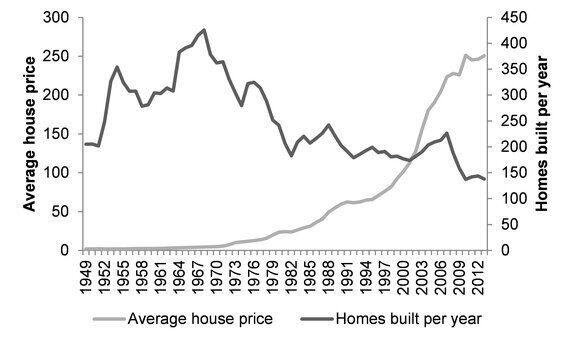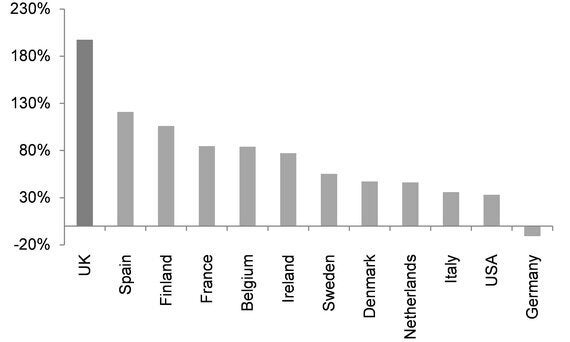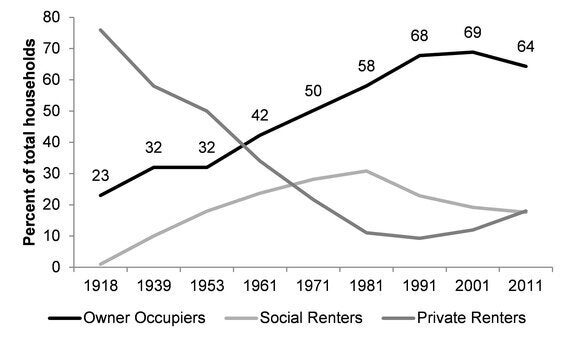We are a property mad nation, we all want our own castle to call home, and yet our property market is in perpetual crisis. We have damagingly high house prices and yet at the same time there is a lack of house building. There is a stream of initiatives from our politicians, but little changes. Here are nine facts that will challenge how you think about the housing crisis.
1. House building needs to more than double
Across the UK we are currently building on average 140,000 homes per year, recent reforms are only increasing this modestly. The UK population is growing at 1%, which is adding around 270,000 new households per year. In addition we have an existing chronic shortage of housing from decades of underinvestment. Therefore we need to build 270,000 homes per year to keep track with population growth, or around 350,000 to reduce the current shortage of housing. This would mean building two cities the size of Bristol every year.
2. Higher house prices do not lead to more house building
Despite decades of house price inflation, house building in the UK has been steadily falling. In few other markets are there increasing prices with falling supply. Imagine each year if the price of milk went up 10%, but each year farmers decided to keep fewer cows, this would be perverse, and yet this is our property market. For decades house prices have increased while house building has fallen. The issue is not a lack of demand, but is supply, the interaction between our planning system and house developers.
UK annual house building and average house prices

3. The UK has seen the fastest house price rises
Unsurprisingly UK house prices have increased faster than most other countries. Since 1980 UK house prices have increased by around 10 times, this compares to around four times for the OECD and euro area. Adjusted for inflation UK house prices have increased by more than any other OECD country, except New Zealand. The chart below shows the real (adjusted for inflation) increase in house prices since 1980 for European countries and the USA.
House price increase since 1980 adjusted for inflation

Source: OECD Housing Prices Database
4. House price rises are driven by bank lending
How have we all afforded such a dramatic increase in prices? Our insatiable appetite for housing has been filled by ever higher bank lending. Total mortgages have increased by 24 times since 1980, to now stand at just over £1trillion. This money has not come from our savings, but instead has been created by banks in the same way we might write an IOU. Our banks provide us with an ever increasing capacity to buy houses, but instead of going into house building, this money enables us to buy houses back and forth from each other at ever higher prices, as if in a never ending game of Jenga where the banks keep giving us the pieces.
Total value of mortgages and average house prices

5. Home ownership is falling
Despite the rising levels of debt to buy houses, home ownership is now falling. Home ownership increased steadily after the Second World War to reach 68% in 1991, it then plateaued reaching only 69% in 2001, then started to fall to 64% in 2011. Therefore during the period of the largest increases in mortgages and house prices, home ownership has not increased.
Home ownership in England and Wales

6. Cost of housing is increasing
Not only is home ownership falling but we're all spending more of our budgets on having somewhere to live. From 1977 to 2010 the proportion of our individual expenditure that went on housing has increased from 14% to 21%. In contrast for the same period the proportion spent on food has fallen from 25% to 15%. The lack of housing is making us all worse off and is acting like a lead weight around our economy. This higher cost is also despite record low interest rates, if interest rates ever return to pre-2009 levels the proportion of our budgets we spend on housing will increase to even higher levels.
7. House prices are double the building cost
Is it the cost that prevents us building homes? No, building houses makes money. The cost of building a house is roughly half the price of the average house. According to a UK government report the average construction cost of a two-bed flat is around £53,000 and £89,000 for a 4-bed detached house. On top of this there are increased demands on infrastructure such as roads, hospitals and schools, a recent housing review put this cost around £55,000. Lastly there is the cost of land, one acre of agricultural land is worth around £9,000, assuming a generous one third plot for each house, means a £3,000 cost. Assuming a mix of flats and detached houses this adds up to around £130,000, half the price of the average home currently at £260,000.
8. Land with planning permission is worth over 100 times more than agricultural land
Of course land in the South East, or with the potential for planning permission, is worth significantly more than the £9,000 for an acre of agricultural land. One acre with planning permission could be worth £500,000 in Birmingham, or £1.7million in outer London. This is a 56 and 189 times uplift in value. This is no great surprise given a house is worth twice what it costs to build.
Source: Estimates based on Valuation Office Agency - Property Market Report 2011, (via The Lyons Housing Review)
9. Only 1% of UK land is housing
We live in a small crowded island, and we need to protect our countryside, but we should put this in perspective. Of all the land in England only 10% is developed, just over half of this, 5% of total land, is for homes and gardens, with only 1% of all land actually used for housing. In contrast 9% of land is protected in national parks, 12% as the green belt and 15% as areas of outstanding natural beauty. Building 350,000 houses is only increasing our housing stock by 1.3% per year and hence only involves building on 0.01% of land each year; a small loss to solve the housing crisis.
Source: National land use database 2005 (via The Lyons Housing Review)
What do we conclude? House building needs radical reform, building needs to double to make a dent in our housing shortage. The current structure of our housing market is broken; house building is falling while prices are rising, despite the fact the price of a home is twice the cost to build one. This is exacerbated by bank lending providing us with an increasing ability to buy houses. Despite this rise in debt, home ownership is actually falling and we're spending more of our budgets on housing. We are rightly protective of our countryside, but housing is only 1% of land use. What value do we place on a green field versus the cost of our current housing shortage?